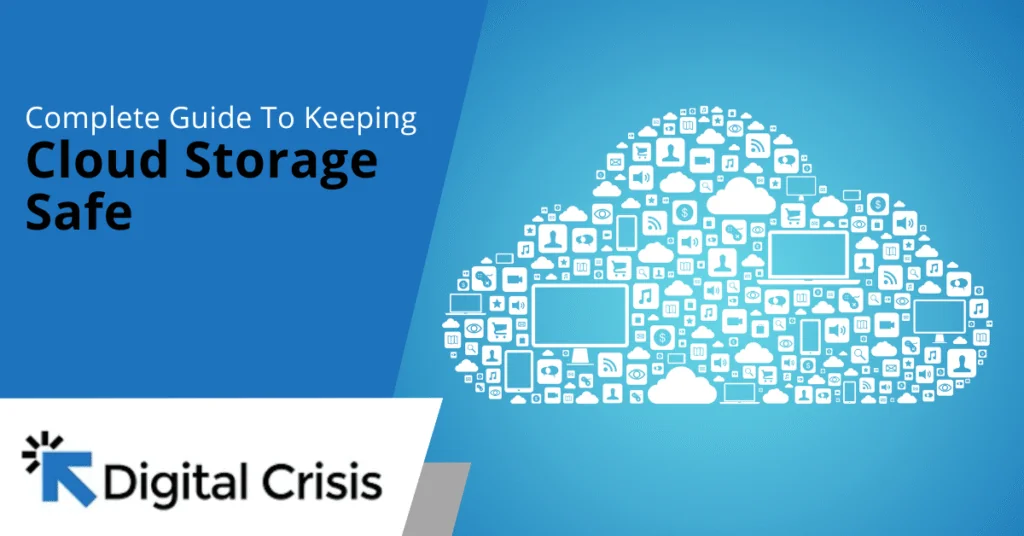Complete Guide To Keeping Cloud Storage Safe

Cloud storage has become an indispensable tool in today’s digital landscape, offering unparalleled convenience and accessibility to data from anywhere. However, this convenience comes with significant security risks, including data breaches, unauthorized access, and misconfiguration issues.
As more businesses and individuals rely on cloud storage, understanding how to secure it is crucial. In this guide, we will explore the importance of cloud storage security, discuss common risks and threats, and provide practical strategies for safeguarding your data in the cloud.
What Is Cloud Storage Security?
Cloud storage security refers to the practices and technologies used to protect data stored in cloud environments from unauthorized access and cyber threats. Cloud storage is generally more secure than traditional storage due to its use of encryption and decentralized data distribution across multiple servers. However, it still faces risks such as data breaches and misconfigurations. Ensuring that your cloud storage solution includes robust security features like end-to-end encryption, multi-factor authentication, and access controls is essential.
Cloud storage providers often employ professional security experts who continuously monitor and update security mechanisms to mitigate emerging threats. The collaboration between cloud security providers and their clients enhances the overall security environment by quickly addressing potential vulnerabilities. Despite these efforts, users must remain vigilant and implement additional security measures to protect their data.
One of the key benefits of cloud storage is its ability to provide data recovery capabilities, which are crucial in case of data loss or deletion. However, this benefit can be undermined if proper security practices are not followed. For instance, if a cloud storage account is compromised due to weak passwords or phishing attacks, sensitive data can be exposed or deleted.
In addition to these risks, cloud storage users must also consider the issue of vendor lock-in, which can limit their ability to switch providers if security concerns arise. This highlights the importance of choosing a cloud storage provider that offers flexible data portability options.
In the next section, we will delve into the common risks associated with cloud storage and discuss strategies for mitigating these threats.
What Are The Risks Associated With Cloud Storage?
Cloud storage, despite its numerous benefits, poses several risks that users must be aware of. These include data breaches, misconfigurations, insecure interfaces, DDoS attacks, malware, insider threats, encryption issues, and patching problems. Data breaches can occur when security measures are inadequate, leading to the exposure of sensitive information. Misconfigurations, such as improperly set access controls or unsecured interfaces, can also provide attackers with easy entry points into cloud systems.
Understanding Data Breaches
Data breaches in cloud storage often result from weak security practices, such as using weak passwords or failing to implement multi-factor authentication. Phishing attacks are particularly effective in cloud environments, as they can trick users into revealing their credentials. Once attackers gain access, they can exploit vulnerabilities like misconfigured firewalls or unsecured APIs to steal sensitive data.
Mitigating Risks
To mitigate these risks, users should implement robust security measures. This includes using strong, unique passwords and enabling multi-factor authentication to prevent unauthorized access. Regularly monitoring cloud storage configurations and ensuring that all interfaces are secure is also crucial. Additionally, encrypting data both in transit and at rest helps protect against interception and unauthorized access.
In the next section, we will explore strategies for securing cloud storage environments, focusing on best practices and advanced security techniques.
How Can You Secure Your Cloud Storage?
Securing cloud storage involves a combination of best practices and advanced security techniques. Implementing identity and access management (IAM) policies is essential to control who can access your data. These policies should include least privilege access, ensuring that users only have the permissions necessary to perform their tasks. Additionally, using key management services (KMS) for data encryption and maintaining detailed logs for auditing purposes are critical components of a secure cloud environment.
Secure Data Access
Access controls are vital in preventing unauthorized data access. This includes setting up access control lists (ACLs) and role-based access control (RBAC) to manage permissions effectively. Regularly reviewing and updating these controls ensures that they remain aligned with changing organizational needs.
Data Encryption
Encrypting data both in transit and at rest is fundamental to cloud storage security. Using modern encryption protocols like TLS 1.2 or higher for data in transit and a KMS for data at rest provides robust protection against unauthorized access. It is also important to ensure that metadata is not stored with sensitive information, as it may not be encrypted.
Data Loss Prevention
Implementing data loss prevention (DLP) systems can help detect and prevent sensitive data from being exposed or deleted. DLP systems are particularly useful in industries handling personal health information (PHI) or personally identifiable information (PII). These systems can flag potential data breaches and automatically remediate violations.
In the next section, we will discuss additional considerations for maintaining a secure cloud environment, including the importance of continuous monitoring and updates.
What Additional Measures Can Enhance Cloud Storage Security?
Beyond the basic security measures, there are several additional strategies that can enhance cloud storage security. Regularly updating software and security patches is crucial to prevent exploitation of known vulnerabilities. Continuous monitoring of cloud configurations and access logs helps identify potential security issues before they become major threats.
Continuous Monitoring
Continuous monitoring involves regularly reviewing cloud storage configurations to ensure they remain secure. This includes checking for misconfigurations, such as public access settings on storage buckets, and ensuring that all interfaces are properly secured. Using tools that automate monitoring tasks can help identify and address security issues more efficiently.
Versioning and Logging
Enabling versioning in cloud storage allows for the preservation and restoration of data in case of loss or corruption. Maintaining detailed access logs provides an audit trail that can help investigate security incidents. These logs should be regularly reviewed to detect any unauthorized access attempts.
Multi-Factor Authentication for Critical Actions
Requiring multi-factor authentication (MFA) for critical actions, such as data deletion, adds an extra layer of security. This ensures that even if an attacker gains access to an account, they cannot perform destructive actions without additional verification.
In the final section, we will summarize key takeaways and provide a call to action for enhancing your cloud storage security.
Taking Action To Secure Your Cloud Storage
Securing cloud storage requires a proactive approach that combines robust security measures with ongoing monitoring and updates. By implementing strong passwords, multi-factor authentication, and data encryption, you can significantly reduce the risk of data breaches and unauthorized access. Additionally, regularly reviewing and updating access controls and configurations ensures that your cloud environment remains secure over time.
To effectively protect your data, it is essential to stay informed about the latest security best practices and technologies. This includes understanding how to mitigate common risks such as misconfigurations and phishing attacks. By taking these steps, you can ensure that your cloud storage remains a safe and reliable solution for storing sensitive information.
Enhancing Your Cloud Security Today
If you are concerned about the security of your cloud storage, it is important to take immediate action. At Digital Crisis, we specialize in providing expert guidance on cloud security and data protection. Whether you need help implementing robust security measures or require assistance in responding to a security incident, our team is here to support you. Contact us today to learn more about how we can help you safeguard your data in the cloud.














